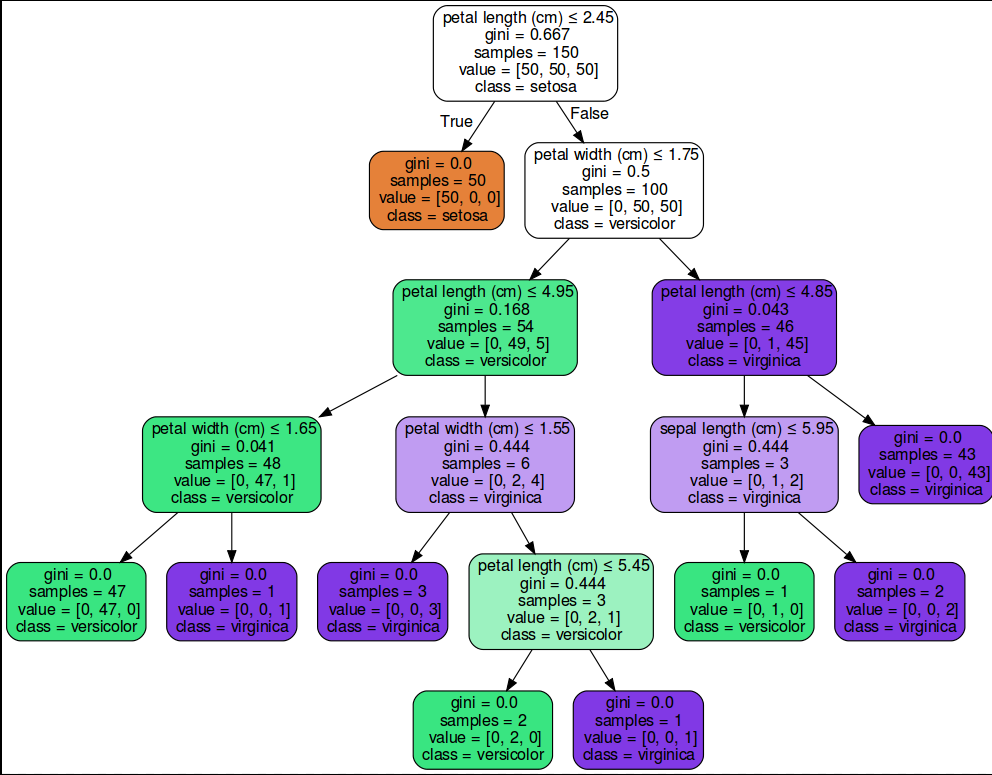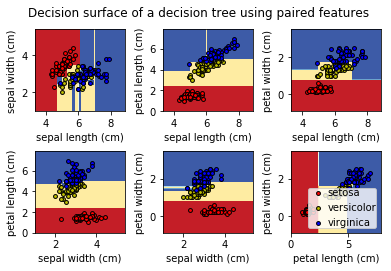绘制决策树
绘制出决策树
经过训练的决策树,我们可以使用 export_graphviz 导出器以 Graphviz 格式导出决策树. 如果你是用 conda 来管理包,那么安装 graphviz 二进制文件和 python 包可以用以下指令安装
conda install python-graphviz
或者,可以从 graphviz 项目主页下载 graphviz 的二进制文件,并从 pypi 安装 Python 包装器,并安装 ‘pip install graphviz` .以下是在整个 iris 数据集上训练的上述树的 graphviz 导出示例; 其结果被保存在 iris.pdf 中:
from sklearn.datasets import load_iris
from sklearn import tree
iris = load_iris()
clf_iris = tree.DecisionTreeClassifier()
clf_iris = clf.fit(iris.data, iris.target)* 下面的代码可以到处我们的决策树 *
:func:export_graphviz 出导出还支持各种美化,包括通过他们的类着色节点(或回归值),如果需要,使用显式变量和类名。
* 注意:默认情况下,会导出图形文件*
* 更详细的内容请参考 sklearn官方文档:sklearn.tree.export_graphviz*
Jupyter notebook也可以自动找出相同的模块
import graphviz # doctest: +SKIP
dot_data = tree.export_graphviz(clf, out_file=None) # doctest: +SKIP
graph = graphviz.Source(dot_data) # doctest: +SKIP
graph.render("iris") # doctest: +SKIP
dot_data = tree.export_graphviz(clf, out_file=None, # doctest: +SKIP
feature_names=iris.feature_names, # doctest: +SKIP
class_names=iris.target_names, # doctest: +SKIP
filled=True, rounded=True, # doctest: +SKIP
special_characters=True) # doctest: +SKIP
graph = graphviz.Source(dot_data) # doctest: +SKIP
graph # doctest: +SKIP* 之后依旧可以使用该函数进行预测数据等操作*
clf_iris.predict(iris.data[:1, :]) array([0])
画出决策树的分类区域
import numpy as np
import matplotlib.pyplot as plt
from sklearn.datasets import load_iris
from sklearn.tree import DecisionTreeClassifier
# Parameters
n_classes = 3
plot_colors = "ryb"
plot_step = 0.02
# Load data
iris = load_iris()
for pairidx, pair in enumerate([[0, 1], [0, 2], [0, 3],
[1, 2], [1, 3], [2, 3]]):
# We only take the two corresponding features
X = iris.data[:, pair]
y = iris.target
# Train
clf = DecisionTreeClassifier().fit(X, y)
# Plot the decision boundary
plt.subplot(2, 3, pairidx + 1)
x_min, x_max = X[:, 0].min() - 1, X[:, 0].max() + 1
y_min, y_max = X[:, 1].min() - 1, X[:, 1].max() + 1
xx, yy = np.meshgrid(np.arange(x_min, x_max, plot_step),
np.arange(y_min, y_max, plot_step))
plt.tight_layout(h_pad=0.5, w_pad=0.5, pad=2.5)
Z = clf.predict(np.c_[xx.ravel(), yy.ravel()])
Z = Z.reshape(xx.shape)
cs = plt.contourf(xx, yy, Z, cmap=plt.cm.RdYlBu)
plt.xlabel(iris.feature_names[pair[0]])
plt.ylabel(iris.feature_names[pair[1]])
# Plot the training points
for i, color in zip(range(n_classes), plot_colors):
idx = np.where(y == i)
plt.scatter(X[idx, 0], X[idx, 1], c=color, label=iris.target_names[i],
cmap=plt.cm.RdYlBu, edgecolor='black', s=15)
plt.suptitle("Decision surface of a decision tree using paired features")
plt.legend(loc='lower right', borderpad=0, handletextpad=0)
plt.axis("tight")
plt.show()




